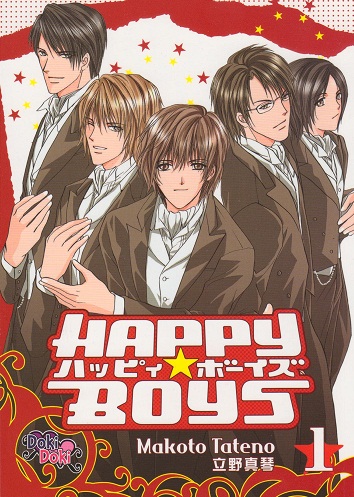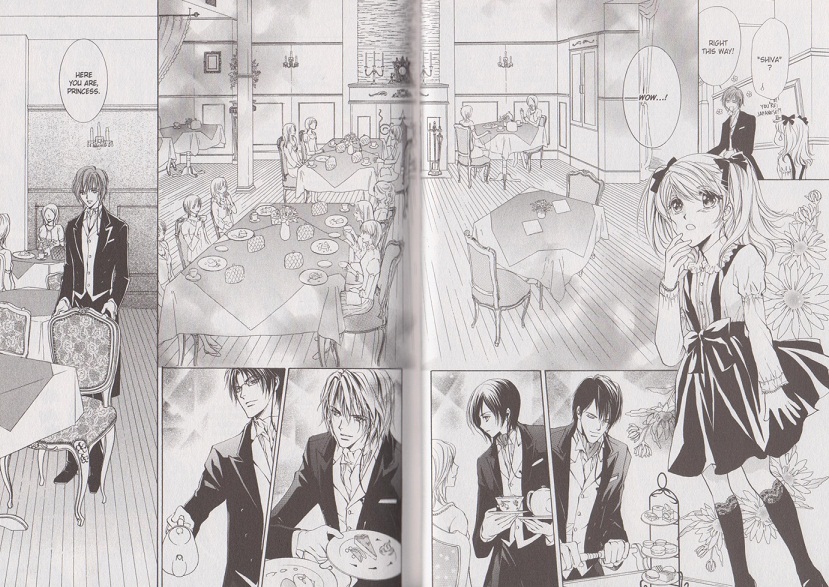 Title: Happy Boys
Title: Happy Boys
Author: Makoto Tateno (How to Capture a Martini)
Publisher: Digital Manga Publishing, on their Doki Doki imprint
Volume: There are only two volumes, and I’ll be looking at both of them today. $12.95 each.
Vintage: 2007 and 2008 by Shinshokan in Japan, 2009 and 2010 (February) by DMP
Misc.: The Happy Boys manga is based on a live action Japanese drama. Featuring the same cast of characters, but different stories, it was meant to be a companion to the television show. Of course, since so little of that sort of thing makes it to America (and what little does tends to be Korean), all you get is the manga.
Happy Boys follows five young men who work at a butler cafe called Lady Braganza. Basically, that’s a fancy, themed tea house, where guys dressed as butlers serve and treat customers as if they are masters and mistresses at a mansion. Employees must be in “character” during operation hours, live in a nearby apartment building, can’t date customers, and must exhibit proper behavior outside of the cafe in case customers happen to see them. It’s an appearance they must keep up, so as not to break the illusion that they aren’t really butlers at a real mansion. Two of the young men, Gen “Silk” Inada and Kokoro “Eve” Tsuruoka, are “first footmen” at the cafe (basically, assistant managers). Three new young men have been recently scouted by the owner to work at the cafe – cheerful and kind Kyoichi “Shiva” Segawa, outgoing former host Junta “Renjo” Akasaka, and cool glasses-wearing Kosuke “Ivory” Kitamura. Running the cafe in the frequent absence of the mysterious owner are strict head butler Tohru Katano and effeminate pastry chef Norikazu Fukawa.
Each volume is a collection of short stories, that generally stand alone, with only one story that really goes across multiple chapters. Each of the boys gets highlighted, though there is some emphasis placed on Kyoichi. The first volume features four stories. In chapter 1, the guys help a little girl bond with her busy father over some tea and cake. Can the guys help heal the rift between father and daughter? In chapter 2, Kosuke, fed up with living in the small cramped apartment he is forced to share with Kyoichi and Junta, decides to take the test to become a first footman at the cafe (so he can have his own room). Will friendship prevail over ambition? Kyoichi takes the stage next, as he starts acting mysterious, and the other boys find him hanging out with one of the female customers. Why is Kyoichi breaking one of the most important rules? The last chapter of the first volume focuses on Gen as he prepares for an acting role; it also explores the friendship between Gen and Kokoro. What happens when Gen gets caught practicing in a park by a customer?

Volume 2 proceeds in much the same way. In the first story, a face from Junta’s host past returns to wage another battle of popularity, as a nearby host club attempts to steal clients away from Lady Braganza. How will the butlers handle their unruly competition? A quick half-chapter follows, showing Kokoro’s otaku nature, as he explores a maid cafe on his day off, and teaches them how to properly make tea. In another mini-chapter, the Happy Boys fret over a creepy mask sent to them by the owner. In the next full chapter, a face from Kosuke’s past comes back to make amends. Head butler Katano takes center stage in the next chapter. The newbies accidentally destroy three containers of important seasonal tea, and Katano travels around the entire city in search of adequate tea leaves, with Kyoichi, Kosuke, and Junta tailing curiously behind him. The last two chapters focus on Kyoichi, who has been approached by a customer who is a real madame, and asked to be a butler at her own house. Can Kyoichi leave all his friends behind for this once in a lifetime opportunity?
The art is up to Tateno’s usual good standard, though it’s a little hard to buy that a couple of these scruffy looking guys work in a classy butler cafe. Though maybe that’s the point. Obviously I’ve never been to one myself. The setup is pretty hard core; they really carry the theme of the cafe pretty far. Again, I don’t know how that compares to the real thing (though I think it’s safe to assume it’s exaggerated to some degree, as most things are). I keep saying “the real thing”…places like this do exist in Japan (in some form), though I think there are more aimed at male patrons (maid cafes) than at girls like the cafe in this story. There’s nothing really wrong with Happy Boys, though it feels like it’s missing something. It’s cute and sweet, but not very deep. There’s a Fumi Yoshinaga manga called Antique Bakery about a bakery/dessert/tea shop run by a group of good looking guys, which has a lot more heart and soul, and is also published by Digital Manga.
Check out more of my reviews of Makoto Tateno’s books.
Kris
kristin@comicattack.net
@girlg33k_Kris
Review copies provided by Digital Manga Publishing.

Hmmm…given the nature of the content it sounds like it should be a sexual thing, but considering your write up, I take it it isn’t?
No, it’s not at all. There’s really nothing sexual about it at all. It’s pretty wholesome, actually.
Sounds like an interesting concept. I wonder what the inspiration was for this work?
For the drama? Real butler cafes, I assume. Somebody thought it was interesting and went “Hey, let’s make a TV show about some guys who work at one of these cafes.” They were either really popular at the time it was made, or someone went to one and thought it would be fun to create a show around it.
Pingback: A busload of otaku « MangaBlog
Pingback: A busload of otaku | Anime Blog Online